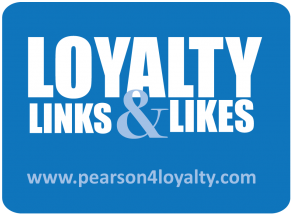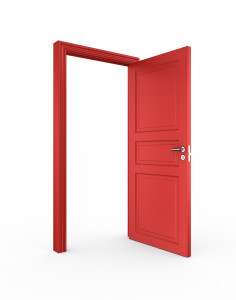Bryan Pearson's Blog, page 40
December 18, 2013
December 18: Loyalty Links & Likes
 Here are a few loyalty links that caught my eye this week.
Here are a few loyalty links that caught my eye this week.
1. The Year in Review: A 2013 Timeline of Loyalty Marketing – COLLOQUY
Ten of the biggest loyalty industry news stories from the past year.
2. News Byte: Order and Ship Emails Are Top Loyalty Recruiters – Direct Marketing News
Recent research reveals that order confirmation emails are highly successful in getting customers to join loyalty programs.
3. The Blind Spot in Customer Loyalty Surveys – The Globe and Mail
The story shares some approaches to measuring customer loyalty.
4. Caesars, Starwood Hotels Link Loyalty Programs to Lure Consumers – Bloomberg BusinessWeek
The entertainment giants have joined forces to let their loyalty members earn points with both programs.
5. The LEGO, Apple, Nordstrom Expert Path to Customer Loyalty – Forbes
How some big name brands are winning big in customer loyalty.
December 16, 2013
New Year’s Resolutions: Lose the Wait, Gain the Faith
 Two of the most common New Year’s resolutions are to exercise more often and to be a better person to others. Well, if a recent forecast of 2014 trends is any indication, loyalty marketers should not have any problem.
Two of the most common New Year’s resolutions are to exercise more often and to be a better person to others. Well, if a recent forecast of 2014 trends is any indication, loyalty marketers should not have any problem.
Marketers will be tasked with being everywhere the consumer is at once, offering especially thoughtful offers, and delivering on all promotional promises. And they will be expected to do this while respecting the consumer’s personal space.
These are the projections of the report, “Trendolutions: 7 Trend-Driven Resolutions for Loyalty Marketers in 2014.” Written by Jeff Berry, research director at COLLOQUY, the report suggests seven business-related resolutions that address key trends in loyalty marketing today.
Among the seven resolutions:
Be omnipresent: Omnichannel distribution and communications has been a hot topic among retailers for the past couple years, and now it is expanding to financial services and travel. An omnichannel strategy requires that the brand make its products and services available everywhere the consumer is, all at once, while maintaining a consistent brand experience. The point is that the consumer does not care which channel she is using, she just wants to order the desired product in the right color while having a pleasant experience. Loyalty programs, as unique identifiers, are key to capturing her preferences however she shops.
Respect the busy signal: The average smartphone user has downloaded 26 apps, but uses only six of them daily, according to the 2013 COLLOQUY study, “Hashtags, Tweets and Likes.” This indicates artificially high expectations – of both the apps’ performance and the consumer’s own free time. Despite the buy-in rate, consumers remain protective of their personal space and time. The increased opportunity to track consumer activity via mobile comes with a responsibility – that loyalty marketers use advanced discretion in their promotions.
Reward well, but fairly: Long-time loyal customers should be rewarded with special perks that reflect their commitment to a brand, from personalized promotions to acceptance into higher-level tiers. But these benefits are not exclusive if anyone has a chance to purchase them. Frequent flyers who rack up 100,000 miles a year have a right to feel indignant when the “elite” airline club they have earned their way into is packed with occasional travellers who just bought access for the day. Loyalty marketers have a responsibility to keep their promise of exclusivity.
These are just the highlights of the report, but to me the takeaway is this: The loyalty marketer is only half of the equation when it comes to achieving success. The formula also requires a consumer –an engaged, committed consumer – to carry us through the year.
That task alone should keep us on our toes, and those who do it well will end 2014 in great shape.
December 11, 2013
December 11: Loyalty Links & Likes
 Here are a few loyalty links that caught my eye this week.
Here are a few loyalty links that caught my eye this week.
1. Pets At Home Loyalty Scheme Strains at the Leash – Financial Times
How the United Kingdom’s largest pet store grew its loyalty program membership to 1.5 million over the course of one year.
2. 7 Trend-Driven Resolutions for Loyalty Marketers in 2014 – COLLOQUY
Seven business-related resolutions that address key issues in loyalty marketing and offers tips to making them actionable.
3. Loyalty and Rewards: How to Collect and Redeem This Holiday Season – Media Planet
An exclusive loyalty supplement to the Toronto Star shares stories with topics including fun things to do with loyalty points and tips to saving money over the holidays.
4. What Businesses Can Learn About Loyalty Programs From Airlines’ Frequent Flier Debacle – Inc.
Two major airlines have been in the press – and court – after booting customers from their frequent flyer programs. This story shares some takeaways for other companies.
5. Apple Success All About Customer Loyalty – Bloomberg TV
A former analyst for Nokia talks about Apple’s strong customer loyalty and the conversion rates between Android and iPhone users.
December 9, 2013
From Loyal to πιστός – Four Differences Between U.S. and European Loyalty Programs
 My dollar may be worth just 70 cents in Europe, but my loyalty rewards, and lessons, run in the multiples.
My dollar may be worth just 70 cents in Europe, but my loyalty rewards, and lessons, run in the multiples.
I’ve had the opportunity recently to travel Europe as a guest of the company BrandLoyalty, a Netherlands-based firm in which my company, LoyaltyOne, is acquiring a major stake. BrandLoyalty operates some of the largest grocery loyalty programs in Europe and Asia. Since it was founded in 1995, BrandLoyalty has created hundreds of individual reward plans.
During our eight-country tour of BrandLoyalty’s operations, I’ve noticed a few key differences between American and European programs. Some I was aware of, but some took me by surprise, and I think my domestic neighbors could benefit from knowing and borrowing from them.
So before I jump on the next high-speed train, I am sharing what I think are the four major differences between U.S. and European loyalty programs:
Coalitions: Think of coalitions as loyalty leagues that are not tied to a credit card. The model, which is popular in many countries outside the United States, allows consumers to accumulate thousands of points on purchases from scores of different participating merchants and then redeem them with any of those partners. The best part: Coalitions are currency neutral, meaning the consumer does not have to use a credit card to earn the points. He or she has the option to use cash, personal check or debit card.
The Members: European shoppers tend to visit stores more frequently than their U.S. counterparts, hitting bakeries, cheese shops and butchers almost daily. This translates to more opportunities for data gathering and customer understanding among merchants. One thing has not changed over the Atlantic, however: Europeans are as price conscious as Americans. As a result, European merchants watch prices in places where consumers are in less of a hurry, such as the hypermarchés.
Multi-motivators: Many European merchants offer more than one loyalty oriented program, layering their own proprietary rewards schemes or coalition program with time-limited promotions to earn merchandise – what are often called “collect-and-saves.” BrandLoyalty, for example, will implement one or a series of tailor-made programs for an individual merchant client, while also managing “Instant Loyalty Promotions” that give customers immediate, collectible rewards based on their spending.
Penetration: Outside of the United Kingdom, which is one of the most sophisticated loyalty markets in the world, Europe is still a relative newbie to loyalty program marketing. However, it is a fast learner. Estimates are that roughly 80 percent of European shoppers belong to at least one loyalty program. In the United States, with 2.65 billion loyalty memberships and a population of 314 million, the ratio is much higher. This spells out significant upside potential for loyalty in the continent.
There are many other small differences between loyalty programs in Europe and the United States. In Europe, for example, many of the cards have tiny chips, not magnetic strips. But regardless of how it is executed or pronounced – in Russian it’s верноподданическо – the word loyalty means the same thing everywhere: It is an emotional connection built on trust.
December 4, 2013
December 4: Loyalty Links & Likes
 Here are a few loyalty links that caught my eye this week.
Here are a few loyalty links that caught my eye this week.
1. This Brand Decided to Charge More on Black Friday, and People Loved It – Adweek
Cards Against Humanity ups prices but is able to win more customer loyalty.
2. A Challenge of Degrees: Attracting Loyalty Marketing’s Future – COLLOQUY
How loyalty marketers can compensate for the predicted shortage of data analysts.
3. 10 Strategies for Choosing the Right Loyalty Incentives – Street Fight Magazine
Loyalty experts offer tips for creating the best smorgasbord of rewards benefits for customers.
4. A Supreme Court Fight for the Rights of (Frequent) Fliers – NPR
A case before the Supreme Court could set the precedent for whether or not frequent fliers have any legal rights in disputes over their memberships.
5. Burger King Tests Fan Loyalty by Giving Away Big Macs – AdAge
The Norway chapter of the fast food chain gave away free Big Mac coupons to weed out impostors from its true loyal followers.
November 27, 2013
November 27: Loyalty Links & Likes
 Here are a few loyalty links that caught my eye this week.
Here are a few loyalty links that caught my eye this week.
1. Celebrity Cruises Overhauls Loyalty Program – USA Today
The cruise line has upgraded its program to cater to those who spend the most.
2. The Data Behind the Turkey: How Black Thursday is Gobbling Sales – COLLOQUY
Why many retailers have decided to open their doors on Thanksgiving and what the data is telling them.
3. Two Easy Ways to Earn Customer Loyalty and Referrals – The Globe and Mail
The author provides two tips for small businesses looking to build loyalty: stay local and focus on the right products.
4. What Starbucks Gets About Loyalty – U.S. News & World Report
How the coffee chain uses gamification to engage its rewards program members and lessons other companies can learn.
5. Frequent-flier Miles Not Always Transferable After Death – Toronto Star
A recent COLLOQUY report reveals company policies for bequeathing loyalty program points after a customer dies.
November 25, 2013
Wine, Hendrix and Vintage Loyalty
 Here’s an exercise for marketers trying to better know their customers: try doing it over a nice glass of Syrah.
Here’s an exercise for marketers trying to better know their customers: try doing it over a nice glass of Syrah.
Chances are the wine – like many customers – will give a different impression at different times. Even connoisseurs struggle with this phenomenon. Thanks to many variables, including the weather, food, and even the music playing, a wine judge’s preferences can oscillate fairly dramatically. According to a story in The Guardian, several research studies bear this out. One judge, Robert Hodgson, has found that only about 10 percent of tasters are consistent in their rankings of the same wine.
The story cites several other studies. One, from Heriot-Watt University in Edinburgh, found that different music could boost the judge’s wine score, sometimes by as much as 60 percent. “Researchers discovered that a blast of Jimi Hendrix enhanced cabernet sauvignon while Kylie Minogue went well with chardonnay,” the report states.
The story went on to identify several other contextual factors that affect a taster’s preference. The palate could be changed by what they’d tasted earlier, the time of day, the amount of sleep they had had, their health and the weather.
Same goes for the everyday shopper upon entering a grocery store, logging on to a website, or checking a promotional message on a smartphone. Each person has a basis of relevance, but it can shift slightly based on a bunch of contextual factors.
This is why I think about relevance in terms of content plus context. The marketing message clearly needs the proper offer to capture the customer’s attention, but it should be framed in an environment that gets customers to pay attention. Our work with high-frequency retailers, for instance, has shown that placing the same offer in a relevant contextual environment can more than double the profit margin per customer.
Such contextual relevance takes time; it is managed across a continuum of customer interactions, spanning months and even years in some cases.
How to begin? Like most customer management strategies, the process should start with segmentation, and sub-segmentation, to create a layering of insights. That said, it’s important to ensure that you don’t make the campaign so complex that it is too onerous to execute reasonably.
Once the marketer has identified its best-prospect customers, it is time to explore the “how” – by creating the proper contextual environment for the brand message. This is where the collected data proves its mettle, and flexibility, because the customer’s location, life stage, individual preference and even activities can alter what is important at that moment.
Purchasing behaviors, for example, may show a shopper buys staple groceries on Sundays, but one or two gourmet items on Thursdays. This may indicate a date night or regular special event that can be enhanced with an offer for flowers or dessert. Likewise, the data can be used to engage new mothers returning to work, specific ethnicities, or a combination of the above three.
Think of it next time you open a bottle of wine. Are you taking into consideration before selecting the wine that it may taste better with one type of food versus another? If not, then think about your planned meal, and how the taste of the food will affect the wine experience. That time given to consider the contextual environment – like pairing an Australian Riesling with a spicy Thai dish – can improve your enjoyment of that wine.
November 20, 2013
November 20: Loyalty Links & Likes
 Here are a few loyalty links that caught my eye this week.
Here are a few loyalty links that caught my eye this week.
1. Lancome’s Loyalty Program Provides a Foundation of Data – Direct Marketing News
A Q&A with the cosmetics retailer about how it uses data collected from its online rewards program.
2. Loyalty’s Seamless Role in Omnichannel Success? – COLLOQUY
Macy’s, U.S. Bank and Delta Air Lines share strategies for maximizing loyalty through omnichannel.
3. Create True Customer Loyalty: 10 Rules – Inc.
Some customer loyalty advice from the author of The Relationship Edge in Business.
4. The Window to Win or Lose Brand Loyalty? 76 Seconds – Retail Customer Experience
Story shares results of a global study that examined trends in online behavior and consumer expectations.
5. Delta, Hilton HHonors and the Missing Loyalty Points – Chicago Tribune
A prolific travel reporter helps elderly couple get back their points and underscores the importance of reading loyalty program point transfer policies
November 18, 2013
The Four Doors to B2B Relevance
 When it comes to reaching customers, the window of opportunity is often realized by traveling through several doors. When that customer is a B2B client, those doors can lead to the executive suite, the manufacturing floor or even the farm field.
When it comes to reaching customers, the window of opportunity is often realized by traveling through several doors. When that customer is a B2B client, those doors can lead to the executive suite, the manufacturing floor or even the farm field.
Consider a day in the life of a business customer. Perhaps a purchase manager just found out she landed a promotion but at an office in another part of town. This event would likely change her needs and preferences. For example, due to her longer commute, the new executive may prefer to get her communications during her drive time via cell phone (hands free, of course).
The point is that the relationship between a loyalty initiative and its customers, regardless of who they are, is a collaborative one, reinforced through meaningful communications and recognition. So how does an organization get there? By being relevant, which comes from understanding four doors that outline the basic behavioral dimensions of the customer: the spatial, temporal, individual, and cohort doors.
I’ve written about the four doors of relevance before, but always applied them to a business-to-consumer relationship. When I began writing my book, “The Loyalty Leap for B2B,” I reconsidered them from the point of a B2B company. Let’s walk through each door together.
Spatial: In the B2B setting, the spatial door refers to physical, online and otherwise digital locations of the customer company. It requires mapping a company’s venues, knowing the whereabouts of its customers, and how the physical and digital locations affect how the organization brings its products to market. All of this means understanding how the company’s customers use its business.
Temporal: In its most basic sense, the word “temporal” means timing. Businesses, like people, have life cycles and life stages that introduce different needs at different points in time. What a business needs at one stage might not be relevant at the next, particularly if it acquires a new competitor or moves offices. Key markers such as size also will shift or introduce needs, in particular with financing, office equipment and government regulations.
Individual: The individual door reveals a company’s interests, mission, and preferences, as well as the unique proclivities of the buyer or business owner who is the contact. However, the B2B operator should recognize the characteristics of the business, not the needs of the individual with whom it is doing business. The needs of the individual in a B2B setting should be viewed as a collective.
Cohort: The last door opens to those characteristics – the moral compass, themes and purposes – that define an organization’s culture, under which its employees come together. These core purposes may include sustainability, which is a focus of Procter & Gamble and Walmart, or shared missions, such as feeding the hungry. The cohort door also discloses a company’s memberships to trade groups or organizations, as well as partnerships with buying groups.
With the use of the four doors, a B2B organization can ensure that everything it does throughout the company is formulated around its customers. Consider a family farm. While the spatial door reveals how different soils and climates affect growing conditions, the temporal door will provide insight into seasonal needs. More intimately, the individual door will open to specific values, such as a preference for recycling, while a membership to the National Family Farm Coalition, exposed through the cohort door, will indicate that the farmer is likely not an agribusiness.
By using the four doors in this way, a company can put the client at the heart of its objectives and develop the kinds of relevant products, promotions, messaging, and delivery that make its customers stop and say, “Hey, they get us.”
That is a sentiment that will open many windows, and doors, of opportunity.
November 13, 2013
November 13: Loyalty Links & Likes
 Here are a few loyalty links that caught my eye this week.
Here are a few loyalty links that caught my eye this week.
1. How to Make Customer Loyalty Pay Off – American Banker
Story shares tips for banks looking to improve their customer loyalty and overall growth.
2. MyWaitrose Loyalty Card Now ‘Used for Half of All Sales’ – The Grocer
Waitrose, the United Kingdom-based supermarket, has created a loyalty program with members that spend twice as much than nonmembers and visit 2.5 times more often.
3. Loyalty Above the Fold: Newspapers Seek Readership in Rewards – COLLOQUY
Some newspapers have turned to rewards programs in their efforts to retain readers and advertisers.
4. Why Walgreens Wants to Follow Your Every Footstep – Chicago Grid
How the drug store is building its wellness brand through an addition to its Balance Rewards program called Steps.
5. Retail Battle of Ontario to Spread – The Globe and Mail
Canadian grocers feel competitive pressures and must get creative in order to attract customers.
Bryan Pearson's Blog
- Bryan Pearson's profile
- 4 followers



